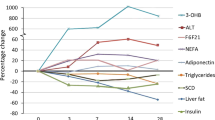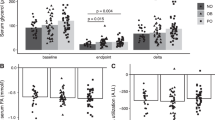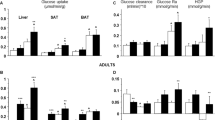Abstract
Objective:
Although insulin resistance in obesity is established, information on insulin action on lipid fluxes, in morbid obesity, is limited. This study was undertaken in morbidly obese women to investigate insulin action on triacylglycerol fluxes and lipolysis across adipose tissue.
Subjects and Design:
A meal was given to 26 obese (age 35±1years, body mass index 46±1 kg m–2) and 11 non-obese women (age 38±2years, body mass index 24±1 kg m–2). Plasma samples for glucose, insulin, triglycerides and non-esterified fatty acids (NEFAs) were taken for 360 min from a vein draining the abdominal subcutaneous adipose tissue and from the radial artery. Adipose tissue blood flow was measured with 133Xe.
Results:
In obese vs non-obese: (1) Arterial glucose was similar, but insulin was increased (P=0.0001). (2) Adipose tissue blood flow was decreased (P=0.0001). (3) Arterial triglycerides (P=0.0001) and NEFAs (P=0.01) were increased. (4) Lipoprotein lipase was decreased (P=0.0009), although the arteriovenous triglyceride differences were similar. (5) Veno-arterial NEFA differences across the adipose tissue were similar. (6) NEFA fluxes and hormone-sensitive lipase-derived glycerol output from 100 g adipose tissue were not different. (7) Total adipose tissue NEFA release was increased (P=0.02).
Conclusions:
In morbid obesity: (a) hypertriglycerinemia could be attributed to a defect in the postprandial dynamic adjustment of triglyceride clearance across the adipose tissue, partly caused by blunted BF; and (b) postprandially, there is an impairment of adipose tissue to buffer NEFA excess, despite hyperinsulinemia.
This is a preview of subscription content, access via your institution
Access options
Subscribe to this journal
Receive 12 print issues and online access
$259.00 per year
only $21.58 per issue
Buy this article
- Purchase on Springer Link
- Instant access to full article PDF
Prices may be subject to local taxes which are calculated during checkout


Similar content being viewed by others
References
Prager R, Wallace P, Olefsky J . In vivo kinetics of insulin action on peripheral glucose disposal and hepatic glucose output in normal and obese subjects. J Clin Invest 1986; 78: 472–481.
Prager R, Wallace P, Olefsky J . Direct and indirect effects of insulin to inhibit hepatic glucose output in obese subjects. Diabetes 1987; 36: 607–611.
Horowitz J, Coppack S, Klein S . Whole-body and adipose tissue glucose metabolism in response to short-term fasting in lean and obese women. Am J Clin Nutr 2001; 73: 517–522.
Frayn K . Adipose tissue as a buffer for daily lipid flux. Diabetologia 2002; 45: 1201–1210.
Coppack S, Evans R, Fisher R, Frayn K, Gibbons G, Humphreys S et al. Adipose tissue metabolism in obesity: lipase action in vivo before and after a mixed meal. Metabolism 1992; 41: 264–272.
Jocken JW, Langin D, Smit E, Saris WH, Valle C, Hul GB et al. Adipose triglyceride (ATGL) and hormone-sensitive lipase (HSL) protein expression is decreased in the obese insulin resistant state. J Clin Endocrin Metab 2007; 92: 2292–2299.
Langin D, Dicker A, Tavernier G, Hoffstedt J, Mairal A, Ryden M et al. Adipocyte lipases and defect of lipolysis in human obesity. Diabetes 2005; 54: 3190–3197.
Virtanen KA, Lozzo P, Hallsten K, Huupponen R, Parkkola R, Janatuinen T et al. Increased fat mass compensates for insulin resistance in abdominal obesity and type 2 diabetes. Diabetes 2005; 54: 2720–2726.
Mitrou P, Boutati E, Lambadiari V, Maratou E, Papakonstantinou A, Komesidou V et al. Rates of glucose uptake in adipose tissue and muscle in vivo after a mixed meal in women with morbid obesity. J Clin Endocrinol Metab 2009; 94: 2958–2961.
Lukaski H, Johnson P, Bolonchuk W, Lykken G . Assessment of fat-free mass using bioelectrical impedance measurements of the human body. Am J Clin Nutr 1985; 41: 810–817.
Dimitriadis G, Mitrou P, Lambadiari V, Boutati E, Maratou E, Panagiotakos D et al. Insulin action in adipose tissue and muscle in hypothyroidism. J Clin Endocrinol Metab 2006; 91: 4930–4937.
Frayn KN, Shadid S, Hamlani R, Humphreys S, Clark M, Fielding B et al. Regulation of fatty acid movement in human adipose tissue in the postabsorptive-to-postprandial transition. Am J Physiol 1994; 266: E308–E317.
Dimitriadis G, Boutati E, Lambadiari V, Mitrou P, Maratou E, Brunel P et al. Restoration of early insulin secretion after a meal in type 2 diabetes: effects on lipid and glucose metabolism. Eur J Clin Invest 2004; 34: 490–497.
Bickerton A, Roberts R, Fielding B, Hodson L, Blaak E, Wagenmakers A et al. Preferential uptake of dietary fatty acids in adipose tissue and muscle in the postprandial period. Diabetes 2007; 56: 168–176.
Reeds D, Stuart C, Perez O, Klein S . Adipose tissue, hepatic and skeletal muscle insulin sensitivity in extremely obese subjects with acanthosis nigricans. Metabolism 2006; 55: 1658–1663.
Riemens S, Sluiter W, Dullaart R . Enhanced escape of non-esterified fatty acids from tissue uptake: its role in impaired insulin-induced lowering of total rate of appearance in obesity and type II diabetes mellitus. Diabetologia 2000; 43: 416–426.
Deurenberg P . Limitations of the bioelectrical impedance method for the assessment of body fat in severe obesity. Am J Clin Nutr 1996; 64 (suppl): 449S–452S.
Acknowledgements
We thank Chr Zervogiani, BS, and A Triantafylopoulou for technical support and V Frangaki, RN, for help with experiments.
Author information
Authors and Affiliations
Corresponding author
Ethics declarations
Competing interests
The authors declare no conflict of interest.
Rights and permissions
About this article
Cite this article
Mitrou, P., Boutati, E., Lambadiari, V. et al. Rates of lipid fluxes in adipose tissue in vivo after a mixed meal in morbid obesity. Int J Obes 34, 770–774 (2010). https://doi.org/10.1038/ijo.2009.293
Received:
Revised:
Accepted:
Published:
Issue Date:
DOI: https://doi.org/10.1038/ijo.2009.293
Keywords
This article is cited by
-
Regulation of human subcutaneous adipose tissue blood flow
International Journal of Obesity (2014)
-
Potential mechanisms of atypical antipsychotic-induced hypertriglyceridemia
Psychopharmacology (2013)
-
Metabolic inflexibility of white and brown adipose tissues in abnormal fatty acid partitioning of type 2 diabetes
International Journal of Obesity Supplements (2012)



